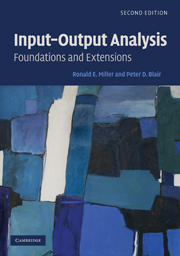Book contents
- Frontmatter
- Contents
- List of Figures
- List of Tables
- Preface
- 1 Introduction and Overview
- 2 Foundations of Input–Output Analysis
- 3 Input–Output Models at the Regional Level
- 4 Organization of Basic Data for Input–Output Models
- 5 The Commodity-by-Industry Approach in Input–Output Models
- 6 Multipliers in the Input–Output Model
- 7 Nonsurvey and Partial-Survey Methods: Fundamentals
- 8 Nonsurvey and Partial-Survey Methods: Extensions
- 9 Energy Input–Output Analysis
- 10 Environmental Input–Output Analysis
- 11 Social Accounting Matrices
- 12 Supply-Side Models, Linkages, and Important Coefficients
- 13 Structural Decomposition, Mixed and Dynamic Models
- 14 Additional Topics
- Appendix A Matrix Algebra for Input–Output Models
- Appendix B Reference Input–Output Tables for the United States (1919–2006)
- Appendix C Historical Notes on the Development of Leontief's Input–Output Analysis
- Author Index
- Subject Index
8 - Nonsurvey and Partial-Survey Methods: Extensions
Published online by Cambridge University Press: 05 June 2012
- Frontmatter
- Contents
- List of Figures
- List of Tables
- Preface
- 1 Introduction and Overview
- 2 Foundations of Input–Output Analysis
- 3 Input–Output Models at the Regional Level
- 4 Organization of Basic Data for Input–Output Models
- 5 The Commodity-by-Industry Approach in Input–Output Models
- 6 Multipliers in the Input–Output Model
- 7 Nonsurvey and Partial-Survey Methods: Fundamentals
- 8 Nonsurvey and Partial-Survey Methods: Extensions
- 9 Energy Input–Output Analysis
- 10 Environmental Input–Output Analysis
- 11 Social Accounting Matrices
- 12 Supply-Side Models, Linkages, and Important Coefficients
- 13 Structural Decomposition, Mixed and Dynamic Models
- 14 Additional Topics
- Appendix A Matrix Algebra for Input–Output Models
- Appendix B Reference Input–Output Tables for the United States (1919–2006)
- Appendix C Historical Notes on the Development of Leontief's Input–Output Analysis
- Author Index
- Subject Index
Summary
Introduction
Regional input–output tables share with their national counterparts the problem of becoming outdated simply because of the passage of time. But smaller geographic scale introduces other problems. For example, if the only automobile assembly plant in Michigan closes and its replacement opens (as the only such plant) in Tennessee, a “national” table would still reflect automobile assembly (although perhaps under more modern methods in the new plant) whereas that activity would disappear entirely from a Michigan table and appear as a completely new activity in a Tennessee table. In addition, states or counties or even smaller economic areas may have fewer resources available for the kinds of data collection needed for survey-based input–output tables – although since the economy is smaller (in terms of number of square miles covered, numbers of active plants, etc.) the effort involved in surveying may be less. In addition, when one is concerned with models in which two or more regions are connected (or a single region and the rest of the country) shipments out of and into the regions assume a much more important role – the former providing inputs to production and the latter representing markets for outputs. Consequently, considerable effort has been devoted to estimation of interregional flows of goods in an effort to construct approximations to and estimates of the arsij or crsi. coefficients of the IRIO or MRIO models (Chapter 3).
As noted in Chapter 3, some of the earliest attempts at estimating interindustry relationships at a regional level employed national input coefficients along with estimates of regional supply percentages showing, for each supplying sector, the proportion of total regional requirements of that good that could be expected to originate within the region.
- Type
- Chapter
- Information
- Input-Output AnalysisFoundations and Extensions, pp. 347 - 398Publisher: Cambridge University PressPrint publication year: 2009



